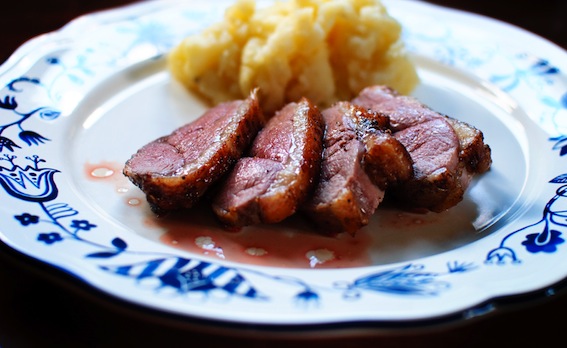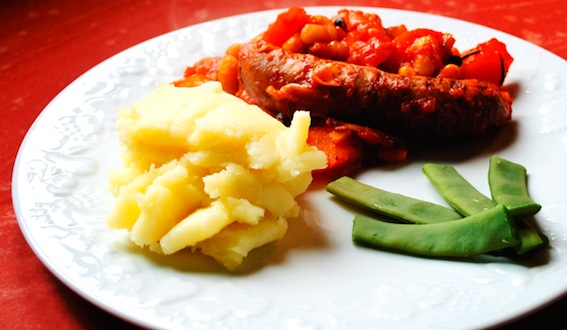-
Floating islands
After three years’ pretending that he’s So Not Bothered by storms, our neurotic labrador has suddenly decided that they absolutely terrify him. He’s gone from superior nonchalence to quivering wreck in one furl swoop; no half-measures with Hugo. Which means that when it’s stormy (which is quite often here in the Spring), I gain an appendage of 30 kilos of black fur, which is a bit of a hindrance for moving around the kitchen (and certainly not a good look).
In spite of my appendage (or perhaps thanks to), I somehow managed to make this which is really delicious. The recipe came from my late mother-in-law.
Ingredients (serves about 6, depending on greed)
1 litre of full-fat milk
120g cane sugar
1 vanilla pod
1 tablespoon of cornflour
4 eggs (preferably free-range)
1 tablespoon of rum (optional)
Heat a glass of the milk and sugar mixture in a saucepan until it starts to simmer. Dilute the cornflour in a tiny bit of water and add to the milk and sugar mixture. Separate the eggs and four yolks to the mixture.
Beat the egg whites (adding a pinch of salt) until firm, then separate with a serving spoon and cook in the remaining milk which should be simmering (this should take about two minutes; one minute on each side). Sieve once cooked.
Add the cooking milk to the milk/cornflour/egg mixture with a whisk and bring to the boil until the mixture thickens (a couple of minutes). Add the rum and pour into a bowl and place the cooked egg whites on top. Refrigerate and serve chilled. -
Duck breast

This is a typical Gascon dish, and one that we enjoy quite frequently. In the winter it’s lovely served with potatoes fried in duck fat and green beans. In the summer it’s delicious finely sliced and served lukewarm on a green salad with orange slices and mint. It should not be overcooked – the meat should be pink. The aim of a good magret de canard is a crisp skin on the outside and liberation of all the fat between the skin and the meat (which is why the fat should be drained off several times).
Everyone benefits from this dish; we eat the meat and the dog eats the fat, which is often slung across the table at him (not by me I hasten to add). Not that he actually sits at the table with us, obviously. It’s funny though how his ‘catch on the fly’ reflexes are spot-on when it comes to catching airborne duck fat, far more so than for catching common or garden morsels.
One last thing. Please remember if asking for this in a restaurant in France that it is ‘magret de canard’ and not, as a friend of my once ordered, ‘magret de connard’; the former is duck breast, the latter roughly translated means ‘breast of arsehole’…
Ingredients (serves 4)
2 duck breasts
rock salt, pepper
1 tablespoon of honey
star anise
Preheat the oven to very hot (220°C). Score the duck breasts on the fatty side using a very sharp knife, cutting in a parallel lines. Generously Season both sides of each breast with the rock salt and pepper and then the honey. Put the two breasts together, fat side out. Bind with colourless string. Cook for 15 minutes on one side, remove from oven and drain the fat. Then 15 minutes on the other side, remove and drain. Put back for another 15 minutes or until the skin is golden brown.
Slice into slices of just under a centimetre and serve. -
Ways with asparagus

Asparagus season started here in early April and is set to continue until the end of May. White asparagus is more common in France and I buy ours direct from the farm up the road. They’re so fresh and tender that I don’t even need to cut the ends off.
Asparagus can be roasted with olive oil and rock salt for about 15/20 minutes, steamed, cooked in simmering water (15 minutes) or even microwaved (although I wouldn’t personally recommend this and I hate microwaves and ours ‘mysteriously’ died an undignified death at the rubbish dump).
One of the classic ways to eat asparagus is with a Hollandaise sauce (very topical at the moment!), which is quite tricky to make but very rewarding if you succeed (good luck!)
Asparagus can be grilled with parma ham (or probably Bayonne ham if you live here!) and parmesan, which is a delicious combination. A great favourite in this area is asparagus omelette, which is a mouth-watering combination of corn-fed chicken eggs, butter and tender aspargus tips. Be sure not to overcook the omelette – the inside should still be slightly runny.
Another traditional way to serve them here is ‘au gratin’. Make a well-seasoned béchamel sauce and then fold in the asparagus and if you like, some ham. Cover the top with grated cheese and a dot of butter. Bake in a hot oven (200°C) until the top is crispy and golden. -
Toulouse sausages and Tarbes beans

I prepared this today for lunch as our son had a friend to stay and ‘bangers, mash and beans’ is always a great favourite with little boys. The advantage of Toulouse sausages is that they are so substantial and meaty that chewing time is longer than less ‘manly’ sausages. Increased chewing time = longer (blissful) silence at the table! What’s not to like?
Ingredients (serves 4)
4 Toulouse sausages
olive oil
can of peeled tomatos
1 onion
2 cloves of garlic
sprig of rosemary
5 medium-sized mushrooms
250g of Tarbes beans (precooked)
Lee and Perrins sauce
Seasoning (sea salt, pepper, cayenne pepper)
Chop the onions, garlic and slice the mushrooms and add to the olive oil in a casserole dish. Sear the sausages for a few minutes on either side on a griddle if you have one, if not in a frying pan and then add to the casserole dish. Once everything is golden brown, add the tomatoes, beans and the rosemary. Season to taste (salt, pepper, cayenne and Lee and Perrins). Cook for about an hour and a half in a medium oven (150°C), until the tomatoes begin to caramelise.
